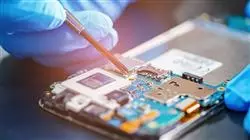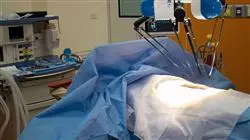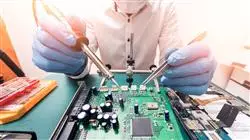University certificate
The world's largest faculty of information technology”
Introduction to the Program
Become an expert in Professional master’s degree and be able to solve those problems in the field of Engineering that enable the development of successful industrial processes”

Electronics are part of daily life for societies, since they are present in basic aspects, such as turning on a television or putting on a washing machine, but also in morerelevant issues such as the creation of medical devices that favor the rise in life expectancy. For this reason, there are many computer scientists who decide to specialize in this field, contributing all their knowledge to continue advancing in a field that is totally relevant to society.
Learn how to apply Electronic Systems in the field of energy efficiency and sustainability, and minimize environmental impacts”
This Professional master’s degree in Electronic Systems Engineering contains the most complete and up-to-date program on the market. The most important features include:
- Practical cases presented by experts in IT
- The graphic, schematic, and practical contents with which they are created, provide scientific and practical information on the disciplines that are essential for professional development
- Practical exercises where self-assessment can be used to improve learning
- Special emphasis on innovative methodologies in Electronic Systems Engineering
- Theoretical lessons, questions to the expert, debate forums on controversial topics, and individual reflection assignments
- Content that is accessible from any fixed or portable device with an Internet connection
The multitude of case studies offered by TECH in this Professional master’s degree will be very useful for effective learning in this field”
The teaching staff includes professionals from the IT sector, who contribute their experience to this program, as well as renowned specialists from leading societies and prestigious universities.
The multimedia content, developed with the latest educational technology, will provide the professional with situated and contextual learning, i.e., a simulated environment that will provide an immersive training experience designed to train for real-life situations.
This program is designed around Problem-Based Learning, whereby the student must try to solve the different professional practice situations that arise throughout the program. This will be done with the help of an innovative system of interactive videos made by renowned experts.
Knowing the features of Electronic Systems Engineering will be a key element for your professional growth"

By enrolling in this Professional master’s degree, you will have unlimited access to all the theoretical and practical resources"
Syllabus
The content of this Professional master’s degree has been designed to meet the academic needs of computer engineers who wish to specialize in Electronic Systems. For this reason, we have compiled the most complete information in this field, which will open the doors for students to a constantly evolving world, which advances at the same pace as new technologies evolve. A first-class program that has been structured in an efficient way to favor learning.

Get to know the particularities of Electronic Systems and learn how to design effective structures”
Module 1. Embedded Systems
1.1. Embedded Systems
1.1.1. Embedded System
1.1.2. Requirements for Embedded Systems and Benefits
1.1.3. Evolution of Embedded Systems
1.2. Microprocessors
1.2.1. Evolution of Microprocessors
1.2.2. Families of Microprocessors
1.2.3. Future Trend
1.2.4. Commercial Operating System
1.3. Structure of a Microprocessor
1.3.1. Basic Structure of a Microprocessor
1.3.2. Central Processing Unit
1.3.3. Input and Output
1.3.4. Buses and Logical Levels
1.3.5. Structure of a System Based on Microprocessors
1.4. Processing Platforms
1.4.1. Cyclic Executive Operation
1.4.2. Events and Interruptions
1.4.3. Hardware Management
1.4.4. Distributed Systems
1.5. Analysis and Design of Programs for Embedded Systems
1.5.1. Requirements Analysis
1.5.2. Design and Integration
1.5.3. Implementation, Tests and Maintenance
1.6. Operating Systems in Real Time
1.6.1. Real Time, Types
1.6.2. Operating Systems in Real Time. Requirements
1.6.3. Microkernel Architecture
1.6.4. Planning
1.6.5. Task Management and Interruptions
1.6.6. Advanced Operating Systems
1.7. Design Technique of Embedded Systems
1.7.1. Sensors and Magnitudes
1.7.2. Low Power Modes
1.7.3. Embedded Systems Languages
1.7.4. Peripherals
1.8. Networks and Multiprocessors in Embedded Systems
1.8.1. Types of Networks
1.8.2. Distributed Embedded Systems Networks
1.8.3. Multiprocessors
1.9. Embedded Systems Simulators
1.9.1. Commercial Simulators
1.9.2. Simulation Parameters
1.9.3. Error Checking and Error Handling
1.10. Embedded Systems for the Internet of Things (IoT)
1.10.1. IoT
1.10.2. Wireless Sensor Networks
1.10.3. Attacks and Protective Measures
1.10.4. Resources Management
1.10.5. Commercial Platforms
Module 2. Electronic Systems Design
2.1. Electronic Design
2.1.1. Resources for the Design
2.1.2. Simulation and Prototype
2.1.3. Testing and Measurements
2.2. Circuit Design Techniques
2.2.1. Schematic Drawing
2.2.2. Current Limiting Resistors
2.2.3. Voltage Dividers
2.2.4. Special Resistance
2.2.5. Transistors
2.2.6. Errors and Precision
2.3. Power Supply Design
2.3.1. Choice of Power Supply
2.3.1.1. Common Voltage
2.3.1.2. Design of a Battery
2.3.2. Switch-Mode Power Supplies
2.3.2.1. Types
2.3.2.2. Pulse Width Modulation
2.3.2.3. Components
2.4. Amplifier Design
2.4.1. Types
2.4.2. Specifications
2.4.3. Gain and Attenuation
2.4.3.1. Input and Output Impedances
2.4.3.2. Maximum Power Transfer
2.4.4. Design with Operational Amplifiers (OP AMP)
2.4.4.1. DC Connection
2.4.4.2. Open Loop Operation
2.4.4.3. Frequency Response
2.4.4.4. Upload Speed
2.4.5. OP AMP Applications
2.4.5.1. Inverters
2.4.5.2. Buffer
2.4.5.3. Adder
2.4.5.4. Integrator
2.4.5.5. Restorer
2.4.5.6. Instrumentation Amplification
2.4.5.7. Error Source Compensator
2.4.5.8. Comparator
2.4.6. Power Amplifier
2.5. Oscillator Design
2.5.1. Specifications
2.5.2. Sinusoidal Oscillators
2.5.2.1. Vienna Bridge
2.5.2.2. Colpitts
2.5.2.3. Quartz Crystal
2.5.3. Clock Signal
2.5.4. Multivibrators
2.5.4.1. Schmitt Trigger
2.5.4.2. 555
2.5.4.3. XR2206
2.5.4.4. LTC6900
2.5.5. Frequency Synthesizers
2.5.5.1. Phase Tracking Loop (PTL)
2.5.5.2. Direct Digital Synthesizer (DDS)
2.6. Design of Filters
2.6.1. Types
2.6.1.1. Low Pass
2.6.1.2. High Pass
2.6.1.3. Band Pass
2.6.1.4. Band Eliminator
2.6.2. Specifications
2.6.3. Behavior Models
2.6.3.1. Butterworth
2.6.3.2. Bessel
2.6.3.3. Chebyshev
2.6.3.4. Elliptical
2.6.4. RC Filters
2.6.5. LC Filters Band Pass
2.6.6. Band-Stop Filter
2.6.6.1. Twin-T
2.6.6.2. LC Notch
2.6.7. Active RC Filters
2.7. Electromechanical Design
2.7.1. Contact Switch
2.7.2. Electromechanical Relays
2.7.3. Solid State Relays (SSR)
2.7.4. Coils
2.7.5. Engines
2.7.5.1. Ordinary
2.7.5.2. Servomotors
2.8. Digital Design
2.8.1. Basic Logic of Integrated Circuits (ICs)
2.8.2. Programmable Logic
2.8.3. Microcontrollers
2.8.4. Morgan’s Theorem
2.8.5. Functional Integrated Circuits
2.8.5.1. Decodifiers
2.8.5.2. Multiplexors
2.8.5.3. Demultiplexers
2.8.5.4. Comparators
2.9. Programmable Logic Devices and Microcontrollers
2.9.1. Programmable Logic Device (PLD)
2.9.1.1. Programming
2.9.2. Field Programmable Logic Gate Array (FPGA)
2.9.2.1. VHDL and Verilog Language
2.9.3. Designing with Microcontrollers
2.9.3.1. Embedded Microcontroller Design
2.10. Choosing Components
2.10.1. Resistance
2.10.1.1. Resistor Encapsulation
2.10.1.2. Manufacturing Materials
2.10.1.3. Standard Values
2.10.2. Capacitors
2.10.2.1. Capacitor Packages
2.10.2.2. Manufacturing Materials
2.10.2.3. Code of Values
2.10.3. Coils
2.10.4. Diodes
2.10.5. Transistors
2.10.6. Integrated Circuits
Module 3. Microelectronics
3.1. Microelectronics vs. Electronics
3.1.1. Analog Circuits
3.1.2. Digital Circuits
3.1.3. Signals and Waves
3.1.4. Semiconductor Materials
3.2. Semiconductor Properties
3.2.1. PN Joint Structure
3.2.2. Reverse Breakdown
3.2.2.1. Zener Breakdown
3.2.2.2. Avalanche Breakdown
3.3. Diodes
3.3.1. Ideal Diode
3.3.2. Rectifier
3.3.3. Diode Junction Characteristics
3.3.3.1. Direct Polarization Current
3.3.3.2. Inverse Polarization Current
3.3.4. Applications
3.4. Transistors
3.4.1. Structure and Physics of a Bipolar Transistor
3.4.2. Operation of a Transistor
3.4.2.1. Active Mode
3.4.2.2. Saturation Mode
3.5. MOS Field-Effect Transistors (MOSFETs)
3.5.1. Structure
3.5.2. The I-V Features
3.5.3. DC MOSFET Circuits
3.5.4. The Body Effect
3.6. Operational Amplifier
3.6.1. Ideal Amplifier
3.6.2. Settings
3.6.3. Differential Amplifiers
3.6.4. Integrators and Differentiators
3.7. Operational Amplifiers. Uses
3.7.1. Bipolar Amplifiers
3.7.2. CMOS
3.7.3. Amplifiers as Black Boxes
3.8. Frequency Response
3.8.1. Analysis of Frequency Response
3.8.2. High-Frequency Response
3.8.3. Low-Frequency Response
3.8.4. Examples:
3.9. Feedback
3.9.1. General Structure of Feedback
3.9.2. Properties and Methodology of Feedback Analysis
3.9.3. Stability: Bode Method
3.9.4. Frequency Compensation
3.10. Sustainable Microelectronics and Future Trends
3.10.1. Sustainable Energy Sources
3.10.2. Bio-Compatible Sensors
3.10.3. Future Trends in Microelectronics
Module 4. Instruments and Sensors
4.1. Measurement
4.1.1. Measurement and Control Characteristics
4.1.1.1. Accuracy
4.1.1.2. Loyalty
4.1.1.3. Repeatability
4.1.1.4. Reproducibility
4.1.1.5. Derivatives
4.1.1.6. Linearity
4.1.1.7. Hysteresis
4.1.1.8. Resolution
4.1.1.9. Scope
4.1.1.10. Errors
4.1.2. Classification of Instruments
4.1.2.1. According to its Functionality
4.1.2.2. According to the Variable to Control
4.2. Regulation
4.2.1. Regulatory Systems
4.2.1.1. Open Loop Systems
4.2.1.2. Closed Loop Systems
4.2.2. Types of Industrial Processes
4.2.2.1. Continuous Processes
4.2.2.2. Discrete Processes
4.3. Caudal Sensors
4.3.1. Flow Rate
4.3.2. Units Used for Caudal Measurement
4.3.3. Types of Caudal Sensors
4.3.3.1. Volume Flow Measurement
4.3.3.2. Flow Measurement by Mass
4.4. Pressure Sensors
4.4.1. Pressure
4.4.2. Units Used for Pressure Measurement
4.4.3. Types of Pressure Sensors
4.4.3.1. Pressure Measurement via Mechanical Elements
4.4.3.2. Pressure Measurement via Electromechanical Elements
4.4.3.3. Pressure Measurement via Electronic Elements
4.5. Temperature Sensors
4.5.1. Temperature
4.5.2. Units Used for Temperature Measurement
4.5.3. Types of Temperature Sensors
4.5.3.1. Bimetallic Thermometer
4.5.3.2. Glass Thermometer
4.5.3.3. Resistance Thermometer
4.5.3.4. Thermistors
4.5.3.5. Thermocouples
4.5.3.6. Radiation Pyrometers
4.6. Level Sensors
4.6.1. Liquids and Solids Level
4.6.2. Units Used for Temperature Measurement
4.6.3. Types of Level Sensors
4.6.3.1. Liquid Level Gauges
4.6.3.2. Solid Level Gauges
4.7. Sensors for Other Physical and Chemical Variables
4.7.1. Sensors for Other Physical Variables
4.7.1.1. Weight Sensors
4.7.1.2. Speed Sensors
4.7.1.3. Density Sensors
4.7.1.4. Humidity Sensors
4.7.1.5. Flame Sensors
4.7.1.6. Solar Radiation Sensors
4.7.2. Sensors for Other Chemical Variables
4.7.2.1. Conduction Sensors
4.7.2.2. pH Sensors
4.7.2.3. Gas Concentration Sensors
4.8. Actuators
4.8.1. Actuators
4.8.2. Engines
4.8.3. Servo-Valves
4.9. Automatic Control
4.9.1. Automatic Regulation
4.9.2. Types of Regulators
4.9.2.1. Two-Step Controller
4.9.2.2. Provider Controller
4.9.2.3. Differential Controller
4.9.2.4. Proportional-Differential Controller
4.9.2.5. Integral Controller
4.9.2.6. Proportional-Integral Controller
4.9.2.7. Proportional-Integral-Differential Controller
4.9.2.8. Digital Electronic Controller
4.10. Control Applications in Industry
4.10.1. Selection Criteria of a Control System
4.10.2. Examples of Typical Controls in Industry
4.10.2.1. Ovens
4.10.2.2. Dryer
4.10.2.3. Combustion Control
4.10.2.4. Level Control
4.10.2.5. Heat Exchangers
4.10.2.6. Central Nuclear Reactor
Module 5. Power Converters
5.1. Power Converter
5.1.1. Power Electronics
5.1.2. Applications of Power Electronics
5.1.3. Power Conversion Systems
5.2. Converters
5.2.1. Converters
5.2.2. Types of Converters
5.2.3. Characteristic Parameters
5.2.4. Fourier Series
5.3. AC/DC Conversion. Single-Phase Uncontrolled Rectifiers
5.3.1. AC/DC Converters
5.3.2. Diode
5.3.3. Uncontrolled Half-Wave Rectifier
5.3.4. Full-Wave Uncontrolled Rectifier
5.4. AC/DC Conversion. Single-Phase Uncontrolled Rectifiers
5.4.1. Thyristor
5.4.2. Half-Wave Controlled Rectifier
5.4.3. Full-Wave Controlled Rectifier
5.5. Three-Phase Rectifiers
5.5.1. Three-Phase Rectifiers
5.5.2. Three-Phase Controlled Rectifiers
5.5.3. Three-Phase Uncontrolled Rectifiers
5.6. DC/AC Conversion. Single-Phase Inverters
5.6.1. DC/AC Converters
5.6.2. Single-Phase Square Wave Controlled Inverters
5.6.3. Single-Phase Inverters Using Sinusoidal PWM Modulation
5.7. DC/AC Conversion. Three-Phase Inverters
5.7.1. Three-Phase Inverters
5.7.2. Three-Phase Square Wave Controlled Inverters
5.7.3. Three-Phase Inverters Using Sinusoidal PWM Modulation
5.8. DC/DC Conversion
5.8.1. DC/DC Converters
5.8.2. DC/DC Converters Classification
5.8.3. DC/DC Converters Control
5.8.4. Reducing Converter
5.9. DC/DC Conversion. Elevating Converter
5.9.1. Elevating Converter
5.9.2. Reducing-Elevating Converter
5.9.3. Cúk Converter
5.10. AC/AC Conversion
5.10.1. AC/AC Converters
5.10.2. AC/AC Converters Classification
5.10.3. Voltage Regulators
5.10.4. Cycloconverters
Module 6. Digital Processing
6.1. Discrete Systems
6.1.1. Discrete Signals
6.1.2. Stability of Discrete Systems
6.1.3. Frequency Response
6.1.4. The Fourier Transform
6.1.5. The Z Transform
6.1.6. Signal Sample
6.2. Convolution and Correlation
6.2.1. Signal Correlation
6.2.2. Signal Convolution
6.2.3. Examples of Application
6.3. Digital Filters
6.3.1. Classes of Digital Filters
6.3.2. Hardware Used for Digital Filters
6.3.3. Frequency Analysis
6.3.4. Effects of the Filter on the Signals
6.4. Non-Recursive Filters (FIR)
6.4.1. Non-Infinite Impulse Response
6.4.2. Linearity
6.4.3. Determination of Poles and Zeros
6.4.4. Design of FIR Filters
6.5. Recursive Filters (IIR)
6.5.1. Recursion in Filters
6.5.2. Infinite Impulse Response
6.5.3. Determination of Poles and Zeros
6.5.4. Design of IIR Filters
6.6. Signal Modulation
6.6.1. Modulation in Amplitude
6.6.2. Modulation in Frequency
6.6.3. Modulation in Phase
6.6.4. Demodulators
6.6.5. Simulators
6.7. Image Digital Processing
6.7.1. Color Theory
6.7.2. Sample and Quantification
6.7.3. Digital Processing with OpenCV
6.8. Advanced Techniques in Image Digital Processing
6.8.1. Image Recognition
6.8.2. Evolutionary Algorithms for Images
6.8.3. Image Databases
6.8.4. Machine Learning Applied to Writing
6.9. Voice Digital Processing
6.9.1. Voice Digital Processing Model
6.9.2. Representation of the Voice Signal
6.9.3. Voice Codification
6.10. Advanced Voice Processing
6.10.1. Voice Recognition
6.10.2. Speech Signal Processing for Diction
6.10.3. Digital Speech Therapy Diagnosis
Module 7. Biomedical Electronics
7.1. Biomedical Electronics
7.1.1. Biomedical Electronics
7.1.2. Characteristics of Biomedical Electronics
7.1.3. Biomedical Instrument Systems
7.1.4. Structure of a Biomedical Instrumentation System
7.2. Bioelectrical Signals
7.2.1. Origin of Bioelectrical Signals
7.2.2. Conduction
7.2.3. Potential
7.2.4. Propagation of Potentials
7.3. Bioelectrical Signal Processing
7.3.1. Bioelectrical Signal Acquisition
7.3.2. Amplification Techniques
7.3.3. Safety and Insulation
7.4. Bioelectrical Signal Filter
7.4.1. Noise
7.4.2. Noise Detection
7.4.3. Noise Filtering
7.5. Electrocardiogram
7.5.1. The Cardiovascular System
7.5.1.1. Action Potentials
7.5.2. ECG Waveform Nomenclature
7.5.3. Cardiac Electric Activity
7.5.4. Electrocardiography Module Instrumentation
7.6. Electroencephalogram
7.6.1. Neurological System
7.6.2. Electrical Brain Activity
7.6.2.1. Brain Waves
7.6.3. Electroencephalography Module Instrumentation
7.7. Electromyogram
7.7.1. The Muscular System
7.7.2. Electrical Muscular Activity
7.7.3. Electromyography Module Instrumentation
7.8. Spirometry
7.8.1. Respiratory System
7.8.2. Spirometric Parameters
7.8.2.1. Interpretation of the Spirometric Test
7.8.3. Spirometry Module Instrumentation
7.9. Oximetry
7.9.1. Circulatory System
7.9.2. Operation Principle
7.9.3. Accuracy of Measurements
7.9.4. Oximetry Module Instrumentation
7.10. Electrical Safety and Regulations
7.10.1. Effects of Electric Currents on Living Things
7.10.2. Electrical Accidents
7.10.3. Electrical Safety of Electromedical Equipment
7.10.4. Classification of Electromedical Equipment
Module 8. Energetic Efficiency, Smart Grid
8.1. Smart Grids and Microgrids
8.1.1. Smart Grid
8.1.2. Benefits
8.1.3. Obstacles for its Implementation
8.1.4. Microgrids
8.2. Measuring Equipment
8.2.1. Architecture
8.2.2. Smart Meters
8.2.3. Sensor Networks
8.2.4. Phasor Measurement Units
8.3. Advanced Measuring Infrastructure (AMI)
8.3.1. Benefits
8.3.2. Services
8.3.3. Protocols and Standards
8.3.4. Confidence
8.4. Distributed Generation and Energy Storage
8.4.1. Generation Technologies
8.4.2. Storage Systems
8.4.3. Electric Vehicle
8.4.4. Microgrids
8.5. Power Electronics in the Energy Field
8.5.1. Smart Grid Requirements
8.5.2. Technologies
8.5.3. Applications
8.6. Demand Response
8.6.1. Objectives
8.6.2. Applications
8.6.3. Models
8.7. General Architecture of Smart Grid
8.7.1. Models
8.7.2. Local Networks: HAN, BAN, IAN
8.7.3. Neighborhood Area Network and Field Area Network
8.7.4. Wide Area Network
8.8. Smart Grid Communications
8.8.1. Requirements
8.8.2. Technologies
8.8.3. Communications Standards and Protocols
8.9. Interoperability, Standards and Security in Smart Grids
8.9.1. Interoperability
8.9.2. Standards
8.9.3. Confidence
8.10. Big Data for Smart Grids
8.10.1. Analytical Models
8.10.2. Scope of Application
8.10.3. Data Sources
8.10.4. Storage Systems
8.10.5. Frameworks
Module 9. Industrial Communications
9.1. The Systems in Real Time
9.1.1. Classification
9.1.2. Programming
9.1.3. Planning
9.2. Communication Networks
9.2.1. Means of Transmission
9.2.2. Basic Configurations
9.2.3. CIM Pyramid
9.2.4. Classification
9.2.5. OSI Model
9.2.6. TCP/IP Model
9.3. Fieldbuses
9.3.1. Classification
9.3.2. Distributed and Centralized Systems
9.3.3. Distributed Control Systems
9.4. BUS
9.4.1. Physical Level
9.4.2. Level of Scope
9.4.3. Error Control
9.4.4. Components
9.5. Elements
9.5.1. Physical Level
9.5.2. Level of Scope
9.5.3. Error Control
9.5.4. DeviceNet
9.5.5. Controlnet
9.6. Profibus
9.6.1. Physical Level
9.6.2. Level of Scope
9.6.3. Level of Application
9.6.4. Communication Model
9.6.5. Operation System
9.6.6. Profinet
9.7. Modbus
9.7.1. Physical Media
9.7.2. Access to the Media
9.7.3. Series Transmission Modes
9.7.4. Protocol
9.7.5. TCP Modbus
9.8. Industrial Ethernet
9.8.1. Profinet
9.8.2. TCP Modbus
9.8.3. Ethernet/IP
9.8.4. EtherCAT
9.9. Wireless Communication
9.9.1. 802.11 Networks (Wifi)
9.9.3. 802.15.1 Networks (BlueTooth)
9.9.3. 802.15.4 Networks (ZigBee)
9.9.4. WirelessHART
9.9.5. WiMAX
9.9.6. Mobile Phone-Based Networks
9.9.7. Satellite Communications
9.10. IoT in Industrial Environments
9.10.1. The Internet of Things
9.10.2. IoT Device Characteristics
9.10.3. Application of IoT in Industrial Environments
9.10.4. Security Requirements
9.10.5. Communication Protocols: MQTT and CoAP
Module 10. Industrial Marketing
10.1. Marketing and Analysis of the Industrial Market
10.1.1. Marketing
10.1.2. Understanding the Market and Customer Guidance
10.1.3. Differences Between Industrial Marketing and Consumer Marketing
10.1.4. Industrial Market
10.2. Marketing Planning
10.2.1. Strategic Planning
10.2.2. Analysis of the Environment
10.2.3. Business Mission and Objectives
10.2.4. The Marketing Plan in Industrial Companies
10.3. Managing the Marketing Information
10.3.1. Knowledge of the Client in the Industrial sector
10.3.2. Learning from the Market
10.3.3. MIS (Marketing Information System)
10.3.4. Commercial Research
10.4. Marketing Strategies
10.4.1. Segmentation
10.4.2. Evaluation and Choice of Target Market
10.4.3. Differentiation and Positioning
10.5. Marketing Relations in the Industrial sector
10.5.1. Creating Relationships
10.5.2. From Transactional Marketing to Relational Marketing
10.5.3. Design and Implementation of an Industrial Relational Marketing Strategy
10.6. Value Creation in the Industrial Market
10.6.1. Marketing Mix and Offering
10.6.2. Advantages of Inbound Marketing in the Industrial Sector
10.6.3. Value Proposal in the Industrial Market
10.6.4. Industrial Purchasing Process
10.7. Pricing Policies
10.7.1. Pricing Policies
10.7.2. Objectives of Pricing Policies
10.7.3. Fixed-Pricing Strategies
10.8. Communication and Branding in the Industrial Sector
10.8.1. Branding
10.8.2. Building a Brand in the Industrial Market
10.8.3. Stages in Communication Development
10.9. Commercial Function and Sales in Industrial Markets
10.9.1. Importance of Commercial Management in the Industrial Company
10.9.2. Sales Force Strategy
10.9.3. Commercial Figure in the Industrial Market
10.9.4. Commercial Negotiation
10.10. Distribution in Industrial Environments
10.10.1. Nature of Distribution Channels
10.10.2. Distribution in the Industrial Sector: Competitive Factor
10.10.3. Types of Distribution Channels
10.10.4. Choosing the Distribution Channel

The most complete Electronic Systems Engineering syllabus currently available”
Professional Master's Degree in Electronics Systems Engineering
If you are an engineer looking for a specialization focused on technological innovation and electronic systems, the Professional Master's Degree program in Electronic Systems Engineering is the perfect option for you. This program gives you the opportunity to deepen your knowledge and development of advanced technologies in electronic systems. The Professional Master's Degree in Electronic Systems Engineering at TECH Global University is designed for engineers seeking to develop skills in the implementation of sophisticated electronic systems. Students will learn to design integrated circuits, control systems, embedded systems, and related technologies. In addition, the Professional Master's Degree focuses on the application of information technology in different areas of engineering.
Electronics and its importance in everyday life
In this sense, TECH's Professional Master's Degree in Electronic Systems Engineering addresses all those issues that are fundamental in everyday life, both on a personal and professional level. In this way, the program develops specialized knowledge in the design of electronic systems and in the world of microelectronics, with special emphasis on instrumentation and sensors that make it possible to control, for example, the presence of a person in a room. The Professional Master's Degree in Electronic Systems Engineering provides students with the skills necessary to lead the next generation of developments in electronic systems and information technology. If you are interested in becoming a Postgraduate Diploma in this field, the program will help you develop technical and practical skills to navigate the challenges of the technology sector. Don't wait any longer to apply and take the first step towards an auspicious career in electronic systems engineering!







